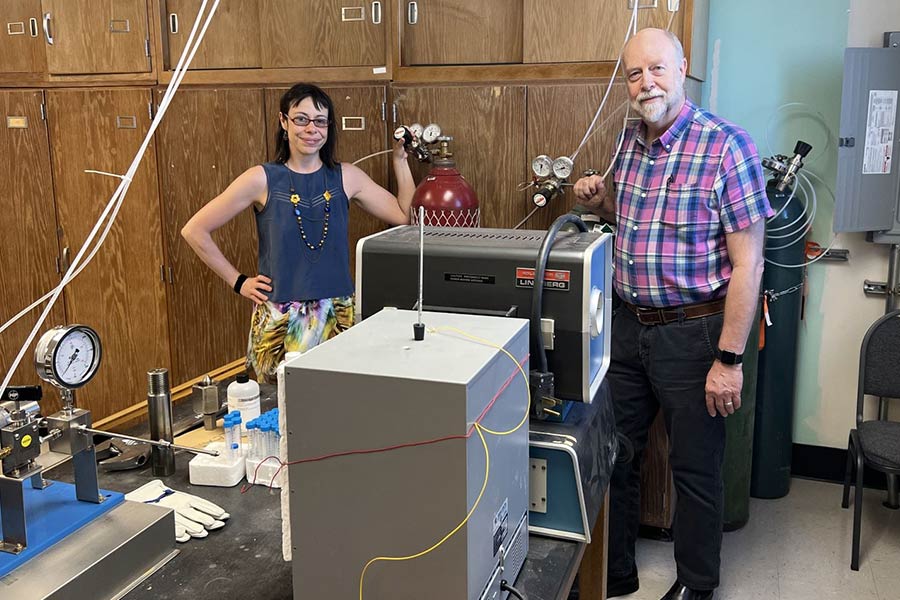Mines Researchers Receive NSF Funding

Press Release: South Dakota Mines
Photo: Dr. Gokce K. Ustunisik and Dr. Roger Nielsen stand in Ustunisik’s laboratory at South Dakota Mines. The data generated with equipment like this gives geologists an understanding of processes happening deep inside the Earth.
RAPID CITY, SD (Sept. 5, 2023) — Everyone knows that lava is made of melted rocks. It makes sense that different types of rocks are produced from different types of lava; for example, the lava in Hawaii is different than the lava common in a Cascadian volcano like Mt. Saint Helens. The rocks and minerals that lava, or magma, become also depends on temperature and pressure conditions during cooling.
Geochemists are interested in understanding how minerals are formed as molten rock cools. This knowledge helps them better understand Earth’s geologic processes from the creation of critical minerals and elements like lithium, to the way plate tectonics can build mountains and cause earthquakes.
Experimental geochemists around the world melt rocks and minerals inside special laboratory furnaces that recreate the environment deep inside the earth. They then look at the minerals that form when various mixtures of material are cooled at different temperatures and pressures.
The large amount of data from such experiments are a challenge to compile for analysis. A team at lead by Gokce K. Ustunisik, Ph.D., associate professor of geology and geological engineering at South Dakota Mines helped build a system to compare results from thousands of experiments conducted around the world. This new study, thanks to a five-year National Science Foundation (NSF) grant totaling nearly $470,000 will help align the data from various sources to build the big picture understanding.
This award is one of four of Ustunisik NSF funded research projects totaling nearly $750,000. The work also ties into the university’s new Ph.D. program in data science and engineering.
A challenge when compiling data from various experiments is that data produced by different labs is not always collected and presented in the professional literature in the same way.
“The way data was collected in multiple experiments can differ greatly. It’s possible to develop bias in predictive models if you don’t consider the boundary conditions of experimental data,” says Ustunisik, the principal investigator on this research.
Roger Nielsen, Ph.D., a co-principal investigator on this research, a research scientist at Mines, and an emeritus professor at College of Earth Ocean and Atmospheric Sciences at Oregon State University uses this analogy to describe this work.
“If your experiment is driving on Interstate-90 east across South Dakota, the data you collect along the first part of the journey tells you you’re going straight and flat and there are no big corners. If you do a second experiment on I-94 across North Dakota, the data shows you the same thing, straight, flat, no corners,” says Nielsen. “A model you might produce based on this data from these two experiments would predict a straight and flat road, and this model would work great, until you hit the Missouri River, and you end up over a cliff in the water. In the two different experiments, you’d go into the water in two different places. The two models going the same direction in two different places would line up for a time but then have different results,” says Nielsen.
Nielsen says the work needed on these experimental geologic datasets includes improved understanding of limitations, gaps, and anomalies such as the Missouri River in the analogy above. With this new understanding, researchers can then examine when different experiments have data that correlates and diverges. They can use this improved understanding to build better models.
“Whatever we do with experiments, our goal is always to simulate what was observed in nature, what we are doing with this is to try and understand the boundary conditions in different experiments so we can warn the modelers about this bias,” Ustunisik adds.
With this new broader understanding, geologists hope to build a more unifying theory or model for the innerworkings of the entire Earth. Nielsen says another analogy is to consider the system that makes up the Earth like the system that makes an automobile.
“Twenty-five years ago, when I began this work, we were trying to determine what all the parts in the car were, the tires, the fenders, the nuts and bolts and bearings that hold the pistons inside the motor. Today we are trying to better understand how these parts fit together and make the car run.”
A model of the entire Earth’s system would be valuable in helping geoscientists predict natural disasters, like earthquakes and volcanic eruptions. This new data analysis research at Mines, brings geologists one step closer to this goal.
###
MEDIA CONTACTS
Mike Ray
Communications Manager
Marketing and Communications
Mike.Ray@sdsmt.edu
605-394-6082
About South Dakota Mines
Founded in 1885, South Dakota Mines is one of the nation’s leading engineering, science and technology universities. South Dakota Mines offers bachelor’s, master’s and doctoral degrees and a best-in-class education at an affordable price. The university enrolls 2,493 students with an average class size of 24. The South Dakota Mines placement rate for graduates is 98 percent, with an average starting salary of $70,036. For these reasons South Dakota Mines is ranked among the best engineering schools in the country for return on investment. Find us online at www.sdsmt.edu and on Facebook, Twitter, LinkedIn, Instagram and Snapchat.
 National Science Foundation RII Track-1 Project:Expanding Research, Education and Innovation in South Dakota
National Science Foundation RII Track-1 Project:Expanding Research, Education and Innovation in South Dakota